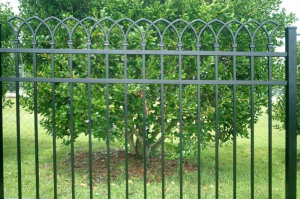 Aluminum fences are the most affordable of metal fencing options, adapt to many different situations, and comes in a variety of textures and colors. Aluminum fencing is powder coated and will not rust. It does not require maintenance and is often manufactured from recycled materials. Aluminum fencing works well in sloped areas because it is ‘racked’, meaning it can follow a slope smoothly without any gaps or holes at the bottom.
Aluminum fences are the most affordable of metal fencing options, adapt to many different situations, and comes in a variety of textures and colors. Aluminum fencing is powder coated and will not rust. It does not require maintenance and is often manufactured from recycled materials. Aluminum fencing works well in sloped areas because it is ‘racked’, meaning it can follow a slope smoothly without any gaps or holes at the bottom.
By the time you reach this point of deciding between aluminum and steel you’re already aware of what your needs are, and when it’s just up to a choice between the two, this is where the tricky questions come into play.
Steel fences and aluminum fences are remarkably similar products, with only a few key differences and benefits to each.
The Benefits To Aluminum Fences
Aluminum fencing has two fundamental practical purposes: the first that it’s a somewhat eco-friendly fence option. A lot of aluminum fence is created from recycled materials, and producing it doesn’t result in a lot of waste. It is also very durable as it’s impervious to the elements, wind, ice, rain, or even standing water. Aluminum stands up to it against everything without being susceptible to damage. Part of this durability comes from the protective coating that’s applied to it.
It’s this protective coating that gives aluminum a wide variety of color and style options. Want the fence in green so it melds in with the grass? Done. Need it in a lush blue so it stands out? Done.
Aluminum is also a light and flexible material to work with, making installation easier than steel.
Benefits Of Steel Fence
Aluminum fencing might be sturdy, but steel fence is even stronger by comparison. It might not have the same elemental resistance that aluminum fence does, but if you fence is going to take a beating, steel is going to be the right choice for you. Most fenced parking lots, for example, will be fenced with steel to help stand up against a car potentially rampaging through them.
The sturdiness of steel fencing is an improvement over aluminum, which also makes it a better security investment if the placement of the fence is in an area where security is a concern.
There are still dozens of design options, but not as many color choices as are offered with aluminum. Steel fence stands up against the wear and tear of time and lasts for quite some time before it needs to be replaced.
Steel is often used as fence post material for wooden fencing, because it lasts so much longer without rot.
Benefits Of Both
Both aluminum fence and steel fence are remarkably sturdy and offer a variety of attractive designs. Both are easily affordable and easily obtainable products.
Drawbacks Of Both
Aluminum fence isn’t as strong as steel. Steel fence will rust faster than aluminum. Steel requires more maintenance than aluminum, as it may need to be repainted at some point. While both of these options have a lot of high points, they’re not without their low ones. Aluminum is cheaper, easier to obtain, and the eco-friendly choice, but the steel fencing offers much more strength and therefore security. At the same time, steel costs more and won’t have the beautiful options and long-lasting benefits that the aluminum fence provides.

